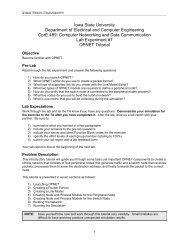Deterministic protocols for real-time communication in multiple ...
Deterministic protocols for real-time communication in multiple ...
Deterministic protocols for real-time communication in multiple ...
Create successful ePaper yourself
Turn your PDF publications into a flip-book with our unique Google optimized e-Paper software.
S. Norden et al. / Computer Communications 22 (1999) 128–136 135effect of the different <strong>in</strong>put parameters, on SR, we canconclude the follow<strong>in</strong>g:• SR vs Load: In Fig. 2(a), as load <strong>in</strong>creases, there is apredictable fall <strong>in</strong> SR values <strong>for</strong> all the three <strong>protocols</strong>as more number of messages are generated and morenumber of collisions, thus reduc<strong>in</strong>g SR.• SR vs a: In Fig. 3(a), as the laxity factor <strong>in</strong>creases, thedeadl<strong>in</strong>e associated with every message <strong>in</strong>creases,result<strong>in</strong>g <strong>in</strong> an <strong>in</strong>crease <strong>in</strong> the number of messagesthat are transmitted successfully, hence <strong>in</strong>creas<strong>in</strong>g SR.• SR vs N: In Fig. 4(a), as the number of nodes<strong>in</strong>creases, the SR falls. This is the result of an <strong>in</strong>crease<strong>in</strong> the number of messages, as well as a larger epoch<strong>time</strong>, which leads to more messages miss<strong>in</strong>g theirdeadl<strong>in</strong>es.• SR vs P/Nt: In Fig. 5(a), as P/Nt is decreased, theper<strong>for</strong>mance will fall expectedly, as a smaller ratioimplies a larger overhead as result of notifier transmission,compared to actual packet transmission.An <strong>in</strong>terest<strong>in</strong>g observation from the graphs is that theECU is not always <strong>in</strong>fluenced by the SR. Normally, onewould expect that as SR decreases, the ECU will alsodecrease s<strong>in</strong>ce less number of slots are used <strong>for</strong> successfultransmission. Some<strong>time</strong>s, this relation may not hold wheneven if less number of messages are transmitted, thecomb<strong>in</strong>ed service <strong>time</strong>s may exceed those of the droppedmessages, which will still <strong>in</strong>crease the ECU (see Fig. 2(a)and (b)). This explanation is supported by the <strong>in</strong>creas<strong>in</strong>gNTL values (<strong>in</strong> Fig. 2(c)) with <strong>in</strong>creas<strong>in</strong>g load, <strong>for</strong> all the<strong>protocols</strong>, imply<strong>in</strong>g that messages with larger service <strong>time</strong>sare transmitted.5. ConclusionsIn this article, we have identified the need <strong>for</strong> <strong>real</strong>-<strong>time</strong><strong>protocols</strong> to support multipacket <strong>real</strong>-<strong>time</strong> message transmissionwhich is the <strong>for</strong>m of <strong>communication</strong> <strong>in</strong> a typical<strong>real</strong>-<strong>time</strong> system. We have highlighted the <strong>in</strong>adequacy ofthe exist<strong>in</strong>g <strong>protocols</strong> to support this requirement. As a solutionto the problem, we have proposed <strong>protocols</strong> with bestef<strong>for</strong>t service <strong>for</strong> <strong>multiple</strong>-access networks, namely, theLDCR and MDCR <strong>protocols</strong>. The MDCR is an extensionof DCR protocol while the LDCR protocol is based on theconcept of message deferment.We have demonstrated the effectiveness of our best ef<strong>for</strong>t<strong>protocols</strong> through simulation, <strong>for</strong> a wide range of parameters<strong>for</strong> <strong>multiple</strong> per<strong>for</strong>mance metrics, by compar<strong>in</strong>gthem with a protocol (PBCSMA) recently proposed <strong>for</strong>the same problem. Our simulation results reveal that theLDCR protocol per<strong>for</strong>ms better than the PBCSMA andMDCR <strong>for</strong> all the three per<strong>for</strong>mance metrics – successratio, effective channel utilization, and normalized transmissionlength. We are currently study<strong>in</strong>g the effect of dynamicallyassign<strong>in</strong>g more than one vertex <strong>in</strong> the CR tree to anode, allow<strong>in</strong>g additional messages to be sent <strong>in</strong> the sameepoch.References[1] K. Arv<strong>in</strong>d, K. Ramamritham, J.A. Stankovic, W<strong>in</strong>dow MAC <strong>protocols</strong><strong>for</strong> <strong>real</strong>-<strong>time</strong> <strong>communication</strong> services, Technical Report, Universityof Massachusetts, USA, 1992.[2] J.I. Capetanakis, Tree algorithm <strong>for</strong> packet broadcast channels, IEEETrans. on Communications 27 (10) (1979) 1476–1484.[3] D.E. Comer, D.L. Stevens, Internet work<strong>in</strong>g with TCP/IP-Volume 2,Prentice-Hall International Inc, Englewood Cliffs, NJ, USA, 1994.[4] Intel Corp., CSMA/DCR determ<strong>in</strong>istic access LANs, PresentationViewgraphs, Folsom Microcomputer Group, Feb. 1988.[5] K.H. Kim, C. Serro, Robustness of <strong>real</strong>-<strong>time</strong> local area network <strong>protocols</strong>,Computer Communications 20 (1997) 169–176.[6] L. Kle<strong>in</strong>rock, Packet switch<strong>in</strong>g <strong>in</strong> radio channels: Part 1 – Carriersense <strong>multiple</strong> access modes and their throughput-delay characteristics,IEEE Trans. on Communications 23 (12) (1975) 1400–1416.[7] J.F. Kurose, M. Schwartz, Y. Yem<strong>in</strong>i, Multiple-access <strong>protocols</strong> and<strong>time</strong>-constra<strong>in</strong>ed <strong>communication</strong>, ACM Comput<strong>in</strong>g Surveys 16 (1)(1984) 43–70.[8] G. Le Lann, N. Rivierre, Real-<strong>time</strong> <strong>communication</strong>s over broadcastnetworks: The CSMA-DCR and the DOD-CSMA-CD <strong>protocols</strong>,Technical Report, Institute National De Recherche En In<strong>for</strong>matiqueEt En Automatique, France, Mar. 1993.[9] N. Malcolm, W. Zhao, Hard <strong>real</strong>-<strong>time</strong> <strong>communication</strong> <strong>in</strong> <strong>multiple</strong>accessnetworks, Real-<strong>time</strong> Systems 8 (1995) 35–77.[10] N. Malcolm, W. Zhao, The <strong>time</strong>d-token protocol <strong>for</strong> <strong>real</strong>-<strong>time</strong><strong>communication</strong>s, IEEE Computer 27 (1) (1994) 35–41.[11] S.K. Oh, G.J. Macewen, Task behaviour monitor<strong>in</strong>g <strong>for</strong> adaptive <strong>real</strong><strong>time</strong><strong>communication</strong>, Real-<strong>time</strong> Systems 11 (1996) 173–195.[12] R. Yavatkar, P. Pai, R. F<strong>in</strong>kel, A Reservation-based CSMA protocol<strong>for</strong> <strong>in</strong>tegrated manufactur<strong>in</strong>g networks, IEEE Trans. on Systems, Manand Cybernetics 24 (8) (1994) 1247–1257.[13] K. Ramamritham, Channel characteristics <strong>in</strong> local-area hard <strong>real</strong>-<strong>time</strong>systems, Computer Networks and ISDN Systems 13 (1987) 3–13.[14] J.A. Stankovic, K. Ramamritham, Hard <strong>real</strong>-<strong>time</strong> systems, ComputerSociety Press of IEEE, 1730, Massachussets Avenue, Wash<strong>in</strong>gton,DC, 1993.[15] O. Ulusoy, Network access protocol <strong>for</strong> hard <strong>real</strong>-<strong>time</strong> <strong>communication</strong>systems, Computer Communications 18 (12) (1995) 943–948.[16] V. Upadhya, Design and Analysis of Real-<strong>time</strong> LAN <strong>protocols</strong>, M.S.Thesis, Department of Computer Science and Eng<strong>in</strong>eer<strong>in</strong>g, IndianInstitute of Technology, Madras, Jan. 1996.[17] W. Zhao, K. Ramamritham, Virtual <strong>time</strong> CSMA <strong>protocols</strong> <strong>for</strong> hard<strong>real</strong>-<strong>time</strong> <strong>communication</strong>, IEEE Trans. on Software Eng<strong>in</strong>eer<strong>in</strong>g 13(8) (1987) 938–952.Samphel Norden obta<strong>in</strong>ed his B.Tech degree <strong>in</strong> Computer Science andEng<strong>in</strong>eer<strong>in</strong>g from the Indian Institute of Technology, Madras, <strong>in</strong> 1998.Currently, he is a research student at the Computer Science Department,University of Wash<strong>in</strong>gton at St. Louis, USA. His research areas of<strong>in</strong>terests are <strong>real</strong>-<strong>time</strong> networks and active networks.S. Balaji obta<strong>in</strong>ed his B.Tech degree <strong>in</strong> Computer Science and Eng<strong>in</strong>eer<strong>in</strong>gfrom the Indian Institute of Technology, Madras, <strong>in</strong> 1998.Currently, he is a research student at the Computer Science Department,University of Ill<strong>in</strong>ois at Urbana Champaign, USA. His researchareas of <strong>in</strong>terest are parallel and distributed comput<strong>in</strong>g and computernetworks.
















